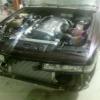Potential Damage With Blown Turbos
Announcements
-
Similar Content
-
Latest Posts
-
How does dead head help with emissions? Is it being claimed for emissions because fuel in the tank isn't being heated up by being pumped around, hence should condense more? One part that is a negative about dead head is heating the fuel at the rail a lot more (IE heat soaking at traffic lights) and this causing lean outs on takeoff afterwards. If my thoughts above are correct, I wonder how different the tail pipe emissions become with the lean outs vs less fuel tank emissions into a charcoal canister
-
By joshuaho96 · Posted
A lot of things we think of as recent are not that recent. Dead head to my knowledge was being done by the early 2000s for evaporative emissions reasons. CARB drove a lot of this with their PZEV requirements. -
Out with the lenso d1 18x10 +20 with 25mm spacers in with the ame 18x11plus 10 no spacers each rim and tyre was 8 kgs lighter lighter which should be noticeable Apprentice helped out
-






Recommended Posts
Create an account or sign in to comment
You need to be a member in order to leave a comment
Create an account
Sign up for a new account in our community. It's easy!
Register a new accountSign in
Already have an account? Sign in here.
Sign In Now